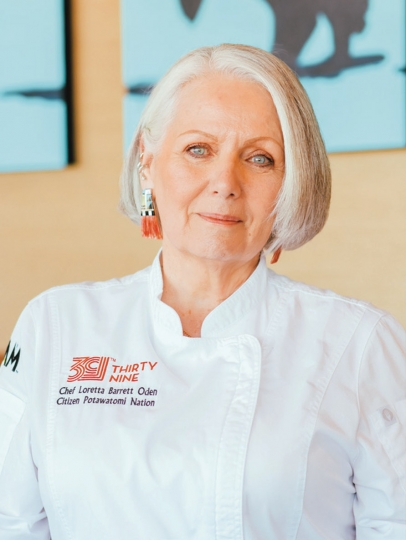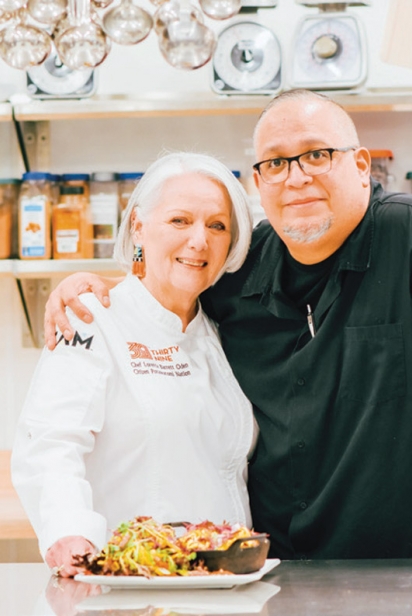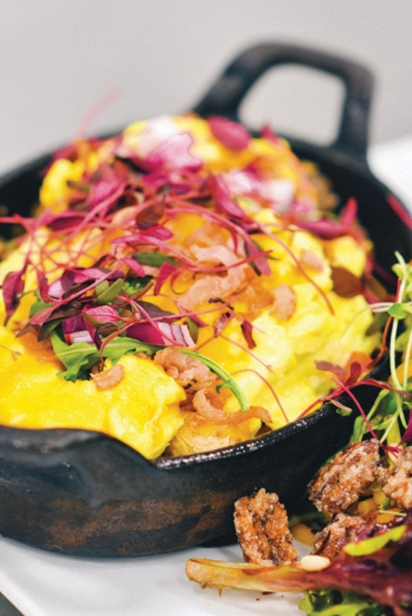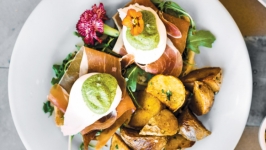The Foods of the First Americans: Chef Loretta Oden's Lifelong Passion
Google “Loretta Oden” and you will discover an impressive bio detailing her career as a chef, writer, and Native food historian, complete with national media appearances. What you won’t feel as much online is her exuberance for life and her genuine care for people, expressed through the food she cooks.
“I love, love, love cooking. I love the kitchen culture. I love meeting new people and feeding people. It makes my heart sing,” Loretta says.
A member of the Citizen Potawatomi Nation, Loretta grew up in a large family in Shawnee. Family is where she gained her foundation in cooking. She learned about food and gardening from her grandmas, aunties, and great-grandparents on both sides of her family. They also taught her about foraging for native fruits and greens—sand plums, wild persimmons, possum grapes, dandelion, henbit, and chickweed.
Although Loretta was raised around relatives, she didn’t learn many of their traditional dishes. Her tribe is originally from the Northeast, but most of the Potawatomi bands now live in the Midwest. She says Removal and Relocation forced them to change their way of eating as they adjusted to a new climate and different plants and animals.
Their food was dictated by the commodities they received from the US government: white wheat flour, sugar, powdered milk, lard, and pinto beans.
“It’s sad how quickly we adapted to the white man’s diet,” she says, “but it was out of necessity.”
Loretta became more practiced in the kitchen while raising her own family—two sons.
“Our house was where all the kids hung out, so I was always cooking for a big herd of boys,” she recalls.
By the time her sons were grown, her interest in indigenous foods had grown as well. She went on a three-year research journey, visiting tribal members across the nation, mostly women, who shared their recipes and traditions with her.
That research laid the foundation for her first restaurant. In 1993, at age 50, she opened the Corn Dance Cafe in Santa Fe, New Mexico, with her oldest son, Clay. She gained national acclaim for her menu showcasing indigenous ingredients.
A decade later, Loretta’s passion for Native food sent her on a new adventure, recording recipes, plant knowledge, and traditions for a ground-breaking culinary travel show.
“We always have been an oral-tradition people. I wanted to make sure that was documented somehow,” she says. “We met so many wonderful people, everyone welcomed us in, and we learned so much about the old ways.”
The result was an Emmy Award winning series, “Seasoned with Spirit: A Native Cook’s Journey,” which aired on PBS.
Loretta’s latest journey brought her home, sharing her lifetime of research at Thirty-Nine Restaurant inside the First Americans Museum, which opened last year. The restaurant pays homage to the state’s thirty-nine tribes. As chef consultant, she creates menus alongside executive chef Brad Harris.
“Loretta is great,” says Brad, who relocated to Oklahoma to help launch Thirty-Nine. “Coming from Alaska, I didn’t know anyone, and Loretta and I clicked right away. She’s one of my best friends.”
He says Loretta has taught him a lot about indigenous foods and helped him rethink what he considered indigenous. Together the duo develops dishes that showcase these ingredients, with a modern flare.
“We are very diverse people with very distinct cultures, ceremonies, and foods,” Loretta says. “I figure if I can make some good food, feed it to my wonderful guests, and get their bellies full, then they’ll listen to what I have to say.”
Thirty-Nine’s menu changes seasonally, and they source as much as they can regionally and from Native producers. Their bison comes from the Cheyenne and Arapaho Tribes, and Ruzycki Farms in Harrah supplies fresh produce.
Popular items include a quartered, oven-roasted corn cob, seasoned with sumac rub, dressed with a smoked jalapeño aioli, cilantro, queso fresco, and chili oil; and a bison burger topped with arugula, pickled red onions, tomato jam, garlic sage aioli, and squash pickles.
Loretta’s passion for healthy eating also shines through the menu.
“Our diet pre-contact was pretty much plant-based throughout the Americas, except in the far north where they had to depend on seals and fish,” she explains. “Native or not, we’ve all gotten into some pretty unhealthy food habits.”
Loretta was reluctant to include fry bread on the menu because it’s unhealthy, but she ended up featuring it because of the important role it plays in Native American history. At Thirty-Nine it’s served as a side to white bean hummus, drizzled with olive oil and sprinkled with pine nuts and sumac.
She is currently working on a cookbook with the University of Oklahoma Press, due out spring 2023, which will document many of her recipes.
As she completes her eighth decade of life, Loretta has a long list of visions for the future, ways she plans to continue to impact the legacy of her people—the First Americans.
> Thirty-Nine Restaurant - First Americans Museum; 659 First Americans Blvd., Oklahoma City; (405) 594-2139; thirtyninerestaurant.com.









